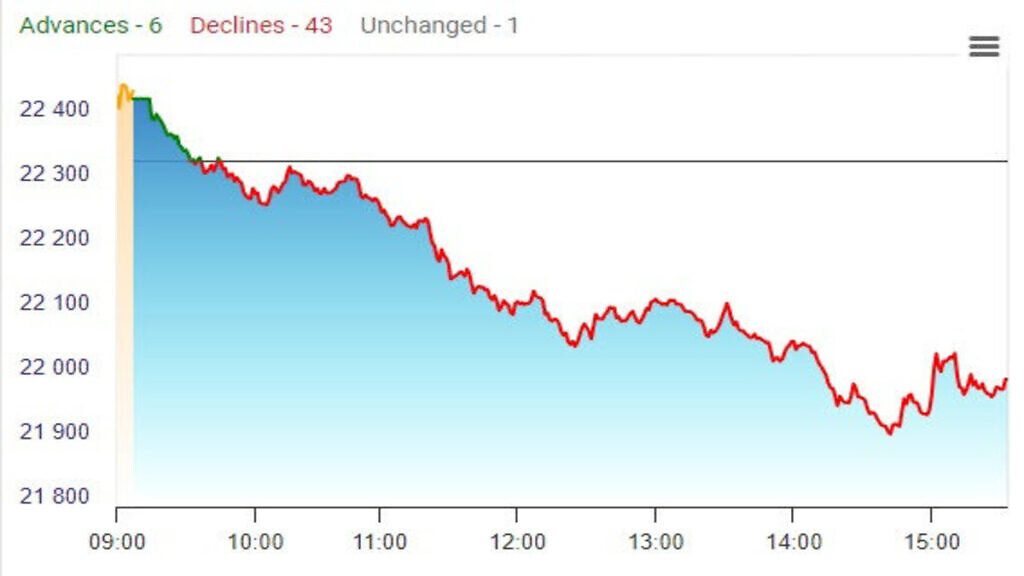Sensex, Nifty tumble up to 1.5% amid broad-based selloff; correction likely to intensify
Yesterday, i.e., the 13th of March 2024, was a real shocker as far as the stocks and shares in the Indian market are concerned.In a seismic event that reverberated through the Indian financial landscape, the Nifty index nosedived by a staggering 1000 points today, wiping out over 800 lac crores of rupees in market value. This unprecedented plunge has left investors grappling with substantial losses and raised concerns about the underlying stability of the market. Let’s delve into the key factors driving this tumultuous episode:

Global Market Turbulence:
The Indian market is not immune to the ripple effects of global economic dynamics. Today’s downturn comes amidst heightened global uncertainty fueled by geopolitical tensions, inflationary pressures, and concerns over the pace of economic recovery post-pandemic. The escalating crisis in [the region] and its implications for global trade have added to the prevailing sense of unease among investors.
The selloff was palpable in the morning trading session, with Gift Nifty trading around the 22,035 level, signaling a negative start for the Indian stock market indices. This initial decline set the stage for a day of intense volatility and rapid market movements.
One of the primary drivers of the market turmoil was the lackluster performance of global markets. Asian markets remained subdued, while US stock indices ended the previous session with a mixed performance. Investors anxiously awaited key data releases on inflation and consumer health, seeking insights into the trajectory of the US Federal Reserve’s policy.
Adding to the uncertainty, the domestic equity indices opened cautiously, echoing the heavy selloff witnessed in the previous session. The Sensex plunged by 906.07 points, or 1.23%, closing at 72,761.89, while the Nifty 50 settled at 338.00 points, or 1.51%, lower at 21,997.70. This broad-based selloff across sectors, particularly affecting mid- and small-cap stocks, reflected the market’s vulnerability to external pressures.
Inflationary Pressures:
Inflationary pressures have been steadily mounting, both domestically and internationally. The specter of rising prices and the potential for central banks to tighten monetary policy to combat inflation have unnerved investors. The fear of interest rate hikes and their impact on borrowing costs and corporate earnings has triggered a flight from risky assets, including equities.
The surge in crude oil prices added to market woes, driven by shrinking US crude stockpiles and escalating tensions in Ukraine. Brent crude futures rose to $84.03 a barrel, while US West Texas Intermediate (WTI) crude futures surged to $79.72 a barrel.
Amidst the market turbulence, US Treasury yields edged higher as investors awaited crucial inflation and consumer health data. However, foreign institutional investors (FIIs) continued to offload Indian shares, net selling shares worth ₹4,595.06 crore, contrasting with domestic institutional investors’ net purchases.
Regulatory Crackdowns:
Heightened regulatory scrutiny across various sectors, particularly technology and finance, has cast a shadow over market sentiment. Recent regulatory interventions targeting major tech giants and financial institutions have injected uncertainty into the market, prompting investors to reassess their risk exposure. The regulatory landscape remains fluid, adding to the prevailing sense of uncertainty.
Notably, regulatory scrutiny from SEBI, coupled with concerns over the outcome of mutual fund stress tests and lofty valuations following a robust rally in recent months, fueled profit booking activities. Analysts cautioned that the market’s sluggishness may persist in the near term, with Nifty’s major support expected around the 21,500 zone.
Profit booking and investor sentiment:
The relentless rally in equity markets in recent months has prompted many investors to book profits amid concerns of overvaluation. Today’s sharp correction may have been exacerbated by profit-taking activities, as investors sought to lock in gains and adopt a more cautious stance. The abrupt shift in sentiment from exuberance to caution has contributed to the heightened volatility witnessed today.
Technical Factors and Market Psychology:
Technical indicators and market psychology also played a significant role in today’s market rout. Technical traders reacting to chart patterns, moving averages, and key support levels may have exacerbated the sell-off as algorithmic trading systems reacted to market signals. The fear of further losses and a herd mentality among investors can exacerbate selling pressure, leading to swift and severe market declines.
As the market grapples with uncertainty and volatility, investors are urged to exercise caution and stay attuned to evolving global and domestic developments. The path ahead remains fraught with challenges, emphasizing the importance of informed decision-making and risk management strategies in navigating turbulent market conditions.
In conclusion, the Indian stock market’s recent meltdown underscores the fragility of financial markets and the myriad factors influencing investor sentiment and market dynamics. As stakeholders brace for continued volatility, a proactive approach to risk mitigation and prudent investment strategies will be paramount in safeguarding portfolios amidst uncertain times.
#IndianStockMarket #NiftyCrash #MarketAnalysis #FinancialLosses #GlobalMarketCues
